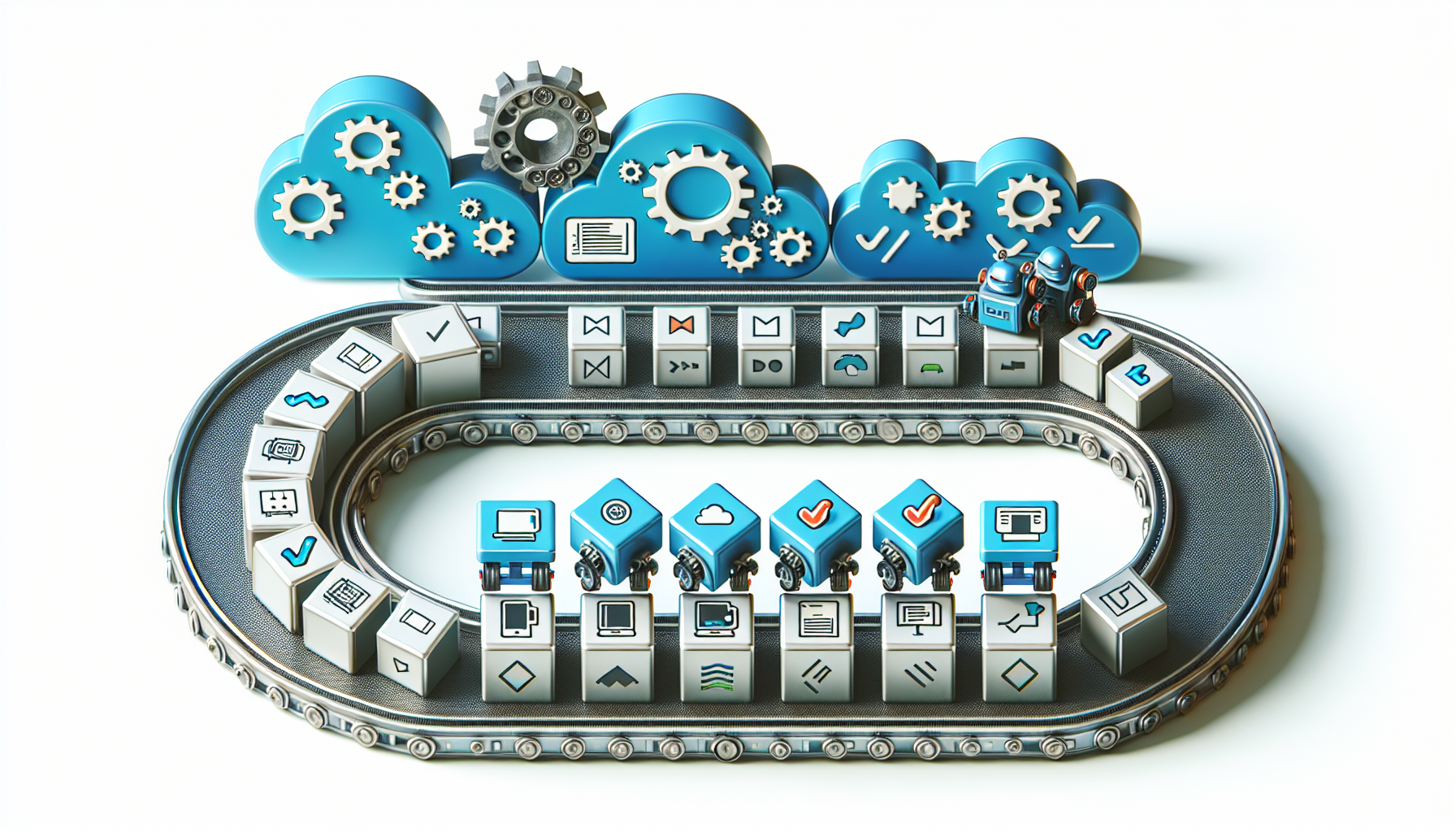Continuous integration vs continuous deployment demystifying CI/CD: two critical practices that shape modern software development. CI focuses on merging all developers’ code changes into a central repository, followed by automated tests, while CD automates code deployment to production after those changes pass stringent tests. This strategic comparison will demystify CI/CD for developers and operations teams looking to refine their production pipeline and deliver high-quality software with speed and precision. Read on to discover not only the distinctions but also the potential integrations of these practices in your work.
Key Takeaways
- Continuous Integration (CI) improves software development through frequent code commits, automated builds and tests, and enhanced collaboration among developers, leading to elevated code quality, productivity, and accelerated release cycles.
- Continuous Deployment (CD) enhances software release processes by automatically deploying all code changes to production after successful testing, thereby speeding up development, minimizing manual errors, and facilitating rapid value delivery to customers.
- While CI and CD are distinct—focusing on regular code integration and automated deployment, respectively—their integration with DevOps amplifies their efficacy by promoting collaboration, communication, automation, and a culture of continuous improvement.
Understanding Continuous Integration
Modern software development relies heavily on CI, as it is instrumental in preserving code quality and fostering efficient teamwork among developers. It is considered a fundamental practice in the industry. Introduced in 1994 by Grady Booch, CI is a practice that involves regular and automated building, testing, and deployment of code changes to a shared repository. This automation of testing and integration of code changes leads to improved reliability, efficiency, accelerated release cycles, and reduced development costs. Through promoting iterative development, CI reduces the likelihood of defects and increases developer productivity, thereby improving the software development process.
CI is all about catching integration issues early, reducing bugs, and improving code quality. The essence of CI is frequent code commits to a shared repository, where automated builds and tests are run. In doing this, CI enhances teamwork among developers and hastens the feedback process, ensuring the code is always ready for deployment and subsequent stages of the delivery cycle.
Key Benefits of CI
The primary advantages of CI reflect its essential principles, primarily by fostering collaboration and eliminating obstacles between development and operations teams. The continuous integration server plays a crucial role in this process, automating the integration, and testing of code changes, resulting in a more streamlined development process and quicker delivery of software.
Moreover, CI reduces bugs in the development process by enabling the integration and testing of small code changes at a time. This process, facilitated through the use of a version control system, minimizes the risk of introducing bugs or errors and simplifies the early detection and rectification of bugs in the development cycle.
Furthermore, CI boosts efficiency in software production by automating routine tasks like building, testing, and deploying code, thereby streamlining the development process and increasing productivity. Ultimately, CI facilitates the swift delivery of software products.
Popular CI Tools
There are several CI tools that have gained popularity in the industry, including Jenkins, Travis CI, CircleCI, and GitLab CI/CD. Jenkins, a Java-based automation platform, is particularly noteworthy for its role in facilitating the continuous creation and testing of software projects, streamlining the integration of changes for developers and DevOps engineers.
Other tools like Travis CI provide features that streamline developer workflows and enable independent execution of tasks such as integration and unit tests. CircleCI enhances Continuous Integration processes by:
- Improving development speed
- Ensuring code quality
- Fostering continuous improvement
- Enabling predictable deployments
- Optimizing pipelines
- Automating testing
- Improving collaboration
GitLab CI/CD distinguishes itself with its comprehensive suite of integrated tools for the complete development process, including idea generation, CI, code review, and deployment.
Understanding Continuous Deployment
Similar to how Continuous Integration simplifies the process of integrating code modifications, Continuous Deployment (CD) automates the release of software. CD refers to a strategy wherein code changes are automatically deployed to the production environment and made accessible to customers after successfully passing automated tests. Its critical components encompass:
- A repeatable and dependable process
- Automation
- Version control
- Integration of quality
- Prioritizing challenging aspects
- Shared responsibility
- A well-defined criterion for considering the software as ‘released’
In CD, automation is essential as it aids in the establishment of CI/CD pipelines and automates the integration, testing, and delivery of code. This automation helps teams concentrate on business requirements while ensuring:
- Consistent and efficient deployment
- Minimization of potential manual errors
- Expedited and dependable code delivery
- Consistently superior quality releases
Key Benefits of CD
Continuous Deployment transcends being a mere methodology; it acts as a springboard for constructive change. CD facilitates the release process by:
- Expediting the pace of development
- Removing the necessity to halt development for releases
- Promoting design thinking and rapid value flow
- Diminishing manual errors by automating the software delivery process
- Reducing the potential risks linked to human intervention and manual release processes.
Further, CD empowers teams to regularly implement small, incremental changes to the production, thereby enabling quicker value delivery and efficient adaptability to changes, ultimately leading to reduced time-to-market. By enabling faster feedback, delivering higher quality software, providing more value through frequent updates, enhancing collaboration between teams, and addressing customer needs and concerns in a timely manner, CD enhances customer satisfaction.
Popular CD Tools
Various tools that are particularly prominent in the realm of Continuous Delivery (CD) include: Jenkins, GitLab CI/CD, Travis CI, Circle CI and GitHub Actions. These tools are popular in the industry for their capability to automate the deployment process, thereby reducing the risk of human error and streamlining workflows.
Some popular tools for continuous deployment are:
- GitLab CI/CD, which automates updates directly to production
- Travis CI, which offers various cloud-based pricing plans and facilitates the deployment of software
- CircleCI, which provides out-of-the-box automation solutions for streamlined deploys
- GitHub Actions, which enables control of deployments through triggering events and allows for the construction of a CI/CD pipeline within GitHub’s ecosystem
These tools are all great options for continuous deployment.
Differences between Continuous Integration and Continuous Deployment
Although both CI and CD are vital components of contemporary software development, they have unique functions. Continuous integration involves frequently integrating code changes, while continuous delivery emphasizes the automated and timely delivery of software to production environments. The precise objectives for Continuous Deployment encompass running multiple builds in parallel and automatically deploying them upon successful testing, continuously deploying small incremental changes to production, executing the continuous deployment pipeline with every commit, shortening the software development cycle, ensuring continuous delivery of high-quality software, promoting execution efficiency, cross-team communication, product market fit, agility, and overall organizational transparency, and minimizing the cycle time needed for writing and testing code.
CI vs CD: Goals and Processes
In terms of objectives and processes, CI and CD focus on early issue detection and facilitating swift, dependable releases. The primary objectives of Continuous Integration include expediting bug identification and resolution, enhancing software quality, and diminishing the duration for validating and releasing new code. Similarly, Continuous Deployment seeks to automate the testing and deployment of new features in production and decrease the cycle time necessary for coding and testing.
CI aids in early issue detection by regularly integrating changes into the main codebase, typically multiple times per day. It incorporates automated testing for crucial code segments, facilitating iterative development and enabling prompt issue resolution by developers. On the other hand, CD facilitates the efficient release of software by subjecting every code change to a series of automated tests. This guarantees that code changes can be swiftly released to the production environment without the need for manual interventions.
CI vs CD: Outcomes and Results
The results of employing CI and CD further underline their unique functions in the software delivery process. Incorporating Continuous Integration into a project brings about:
- Iterative software development
- Mitigation of risks associated with defects
- Enhancement of the productivity of developers
- Diminishing production bugs
- Lessening the accumulation of bugs in a software project
CI also aids in diminishing production bugs and lessening the accumulation of bugs in a software project.
On the other hand, Continuous Deployment facilitates the release process by:
- Automating the release pipeline
- Enabling teams to release high-quality code at a faster and more frequent rate
- Separating the deployment and release processes, which promotes design thinking and rapid value flow
- Maintaining consistent quality of software releases by automating the software development and code release process, including release testing
- Enabling teams to deploy small, incremental changes to production continually
The Role of DevOps in CI/CD

DevOps boosts CI/CD process efficiency by encouraging essential practices like collaboration, communication, and automation, consequently leading to a more agile, streamlined, and productive software creation process. This collective effort contributes to the delivery of high-quality software in a swift and reliable manner.
Collaboration and Communication
DevOps places a strong emphasis on:
- Collaboration and communication
- Efficient teamwork
- Streamlining software development
- Enhancing organizational performance
- Promoting interaction and information exchange between development and operations teams
- Facilitating CI/CD processes
These factors are pivotal in attaining success in software development.
To enhance collaboration and communication within a DevOps team, the following strategies can be implemented:
- Daily standups
- Establishing common objectives
- Nurturing cross-functional teams
- Utilizing transparent communication platforms
- Consistently seeking feedback and opportunities for enhancement
These strategies break down organizational barriers and stimulate creative problem solving, leading to a more efficient and effective software delivery process while maintaining existing functionality.
Automation and Infrastructure Management
Automation and infrastructure management are key facets of DevOps that streamline CI/CD processes. The implementation of automation in CI/CD processes facilitates the efficient execution of code building, testing, and deployment, enabling developers to merge changes into a unified repository with greater effectiveness.
Several primary automation tools utilized in DevOps for CI/CD are: Jenkins, CircleCI, TeamCity, Bamboo, GitLab, Buddy, Travis CI, Codeship, GoCD, Wercker and Semaphore
Infrastructure management holds a pivotal role in ensuring the successful execution of CI/CD practices. It encompasses the automation of infrastructure through Infrastructure as Code (IaC), enabling the automation of application building, testing, and deployment, as well as infrastructure configurations.
Best Practices for Implementing CI/CD
Similar to any other methodology, the effectiveness of CI/CD hinges on the quality of its implementation. Effective communication enhances the execution of CI/CD by facilitating the sharing of information, updates, and feedback among teams in a timely manner. This fosters alignment and enables efficient collaboration, ultimately contributing to smoother and more effective development and deployment processes.
Automation plays a pivotal role in the successful implementation of CI/CD. It facilitates meaningful and effective execution of CI/CD, with automation testing serving as a fundamental component of any CI/CD pipeline. Automation enables continuous integration, thereby enabling more frequent code merging.
The integration of DevOps and Agile methodologies contributes to the improvement of CI/CD implementation by fostering mutual support and facilitating collaboration among teams to pursue a shared objective. Agile practices establish a robust framework for continuous delivery by dividing intricate tasks into more manageable, smaller units.
Overcoming Challenges in CI/CD Adoption
The adoption of CI/CD comes with its own set of challenges. However, with the right strategies in place, these challenges can be overcome. One of the key methods organizations can employ to automate manual processes during the transition to CI/CD is by:
- Establishing fast, reliable, and frequent integrations
- Implementing automated deployment for simplified operation
- Utilizing CI/CD pipeline automation to enhance the software delivery process, minimize manual errors, and facilitate more efficient team collaboration
CI/CD and DevOps are transformative practices in modern software development, promoting a culture of collaboration, automation, and shared responsibilities. CI and CD, while serving distinct roles, both contribute to a more efficient and effective software delivery process. CI focuses on frequent code integration to detect and resolve issues early, while CD automates software releases, reducing manual errors, and ensuring consistent quality.
The adoption and successful implementation of CI/CD and DevOps practices require effective communication, automation, gradual implementation, and continuous monitoring and improvement. By overcoming challenges in CI/CD adoption and leveraging best practices, organizations can achieve a streamlined software delivery process, shorter time-to-market, and improved customer satisfaction.
Frequently Asked Questions
What’s the difference between continuous integration CI and continuous deployment CD )?
Continuous integration focuses on preparing code for release, while continuous deployment involves the actual release of code. In other words, CI is the first stage in producing and delivering code, while CD is the second stage.
What is the difference between Jenkins and other continuous integration continuous delivery CI CD tools?
The main difference between Jenkins and other CI/CD tools is that Jenkins focuses on automating the integration process of code changes, including building, testing, and deploying, as part of the CI development practice.
What is continuous integration in CI CD?
Continuous integration (CI) is a software development practice in which developers merge their changes to the main branch many times per day, triggering an automated code build and test sequence. This ensures that code changes are integrated and tested frequently for reliability.
What are the primary objectives of Continuous Deployment?
The primary objectives of Continuous Deployment are to run multiple builds in parallel, automatically deploy them upon successful testing, continuously deploy small incremental changes to production, and shorten the software development cycle.
What are the best practices for implementing CI/CD?
The best practices for implementing CI/CD include effective communication, automation, integration with DevOps and Agile methodologies, gradual implementation, and continuous monitoring and improvement. These practices can help streamline the development and deployment processes for software projects.





0 Comments